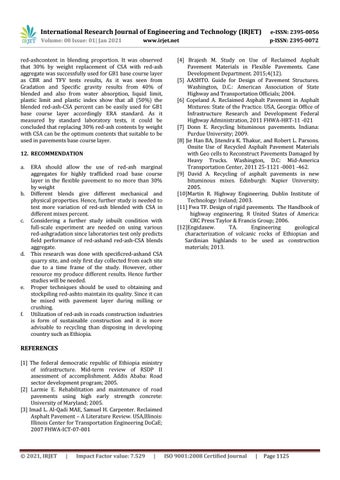International Research Journal of Engineering and Technology (IRJET)
e-ISSN: 2395-0056
Volume: 08 Issue: 01| Jan 2021
p-ISSN: 2395-0072
www.irjet.net
red-ashcontent in blending proportion. It was observed that 30% by weight replacement of CSA with red-ash aggregate was successfully used for GB1 base course layer as CBR and TFV tests results, As it was seen from Gradation and Specific gravity results from 40% of blended and also from water absorption, liquid limit, plastic limit and plastic index show that all (50%) the blended red-ash-CSA percent can be easily used for GB1 base course layer accordingly ERA standard. As it measured by standard laboratory tests, it could be concluded that replacing 30% red-ash contents by weight with CSA can be the optimum contents that suitable to be used in pavements base course layer. 12. RECOMMENDATION a.
b.
c.
d.
e.
f.
ERA should allow the use of red-ash marginal aggregates for highly trafficked road base course layer in the flexible pavement to no more than 30% by weight Different blends give different mechanical and physical properties. Hence, further study is needed to test more variation of red-ash blended with CSA in different mixes percent. Considering a further study inbuilt condition with full-scale experiment are needed on using various red-ashgradation since laboratories test only predicts field performance of red-ashand red-ash-CSA blends aggregate. This research was done with specificred-ashand CSA quarry site, and only first day collected from each site due to a time frame of the study. However, other resource my produce different results. Hence further studies will be needed. Proper techniques should be used to obtaining and stockpiling red-ashto maintain its quality. Since it can be mixed with pavement layer during milling or crushing. Utilization of red-ash in roads construction industries is form of sustainable construction and it is more advisable to recycling than disposing in developing country such as Ethiopia.
[4] Brajesh M. Study on Use of Reclaimed Asphalt Pavement Materials in Flexible Pavements. Cane Development Department. 2015;4(12). [5] AASHTO. Guide for Design of Pavement Structures. Washington, D.C.: American Association of State Highway and Transportation Officials; 2004. [6] Copeland A. Reclaimed Asphalt Pavement in Asphalt Mixtures: State of the Practice. USA, Georgia: Office of Infrastructure Research and Development Federal Highway Administration, 2011 FHWA-HRT-11 -021 [7] Donn E. Recycling bituminous pavements. Indiana: Purdue University; 2009. [8] Jie Han BA, Jitendra K. Thakur, and Robert L. Parsons. Onsite Use of Recycled Asphalt Pavement Materials with Geo cells to Reconstruct Pavements Damaged by Heavy Trucks. Washington, D.C: Mid-America Transportation Center, 2011 25-1121 -0001 -462. [9] David A. Recycling of asphalt pavements in new bituminous mixes. Edinburgh: Napier University; 2005. [10]Martin R. Highway Engineering. Dublin Institute of Technology: Ireland; 2003. [11] Fwa TF. Design of rigid pavements. The Handbook of highway engineering. R United States of America: CRC Press Taylor & Francis Group; 2006. [12]Engidasew. TA. Engineering geological characterization of volcanic rocks of Ethiopian and Sardinian highlands to be used as construction materials; 2013.
REFERENCES [1] The federal democratic republic of Ethiopia ministry of infrastructure. Mid-term review of RSDP II assessment of accomplishment. Addis Ababa: Road sector development program; 2005. [2] Larmie E. Rehabilitation and maintenance of road pavements using high early strength concrete: University of Maryland; 2005. [3] Imad L. Al-Qadi MAE, Samuel H. Carpenter. Reclaimed Asphalt Pavement – A Literature Review. USA,Illinois: Illinois Center for Transportation Engineering DoCaE; 2007 FHWA-ICT-07-001
Š 2021, IRJET
|
Impact Factor value: 7.529
|
ISO 9001:2008 Certified Journal
|
Page 1125

